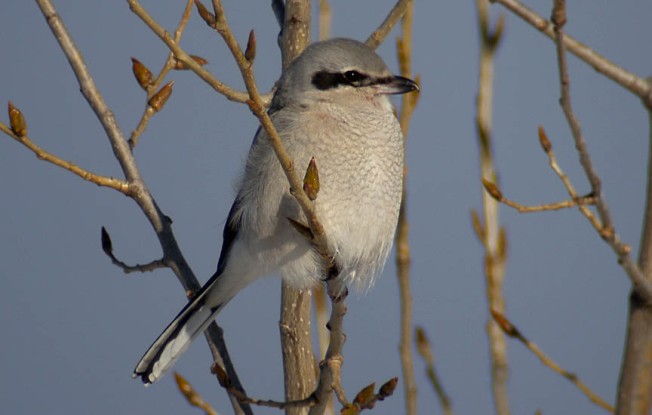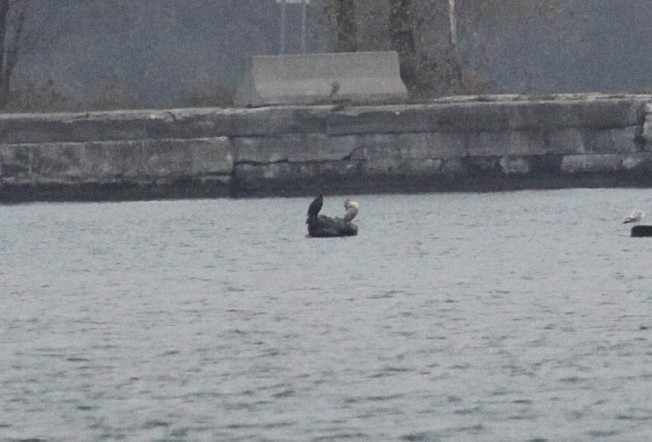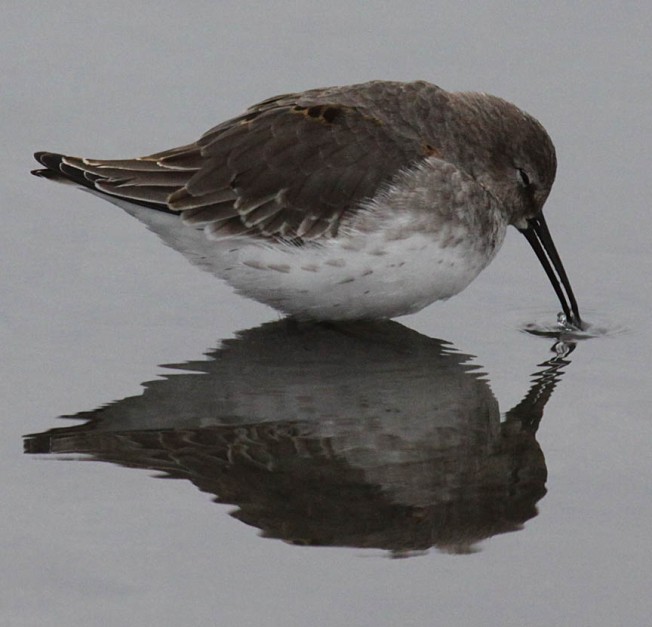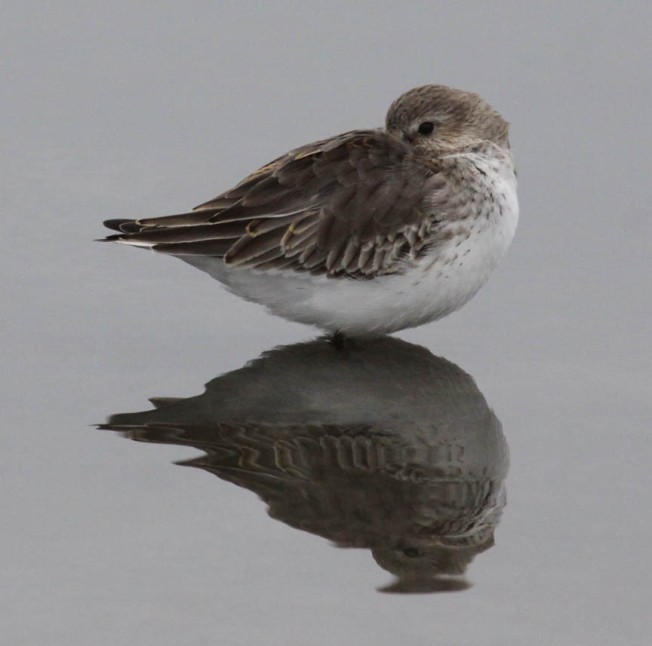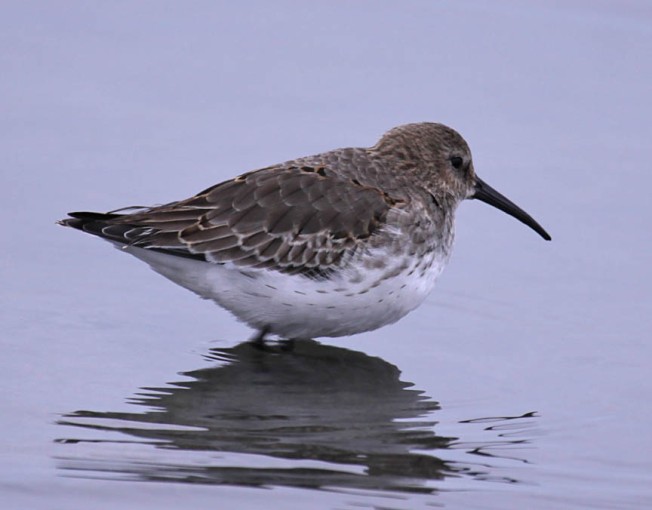After the roaring success of the weekends twitch it was back to St-Lazare sand pits on Monday 29-October. Heavy rain kept me out of the field until 9.30 and the fresh and chilly north-westerly that greeted me hinted that this might be a short visit. The water area had already been vacated by most of the Canada Geese, post roost, but six of the ten Ruddy Ducks remained. These Ruddy Ducks have to be of a more westerly origin, it is a relatively uncommon species in Québec and there are no real northerly breeding populations that would account for their presence. The odd one could be just a wandering immature, they do that, but ten is an influx – I wonder how many other waters have them in this area.
Below a rubbish photo of nine of the birds, don’t tell DEFRA where they are (DEFRA are in the process of killing all the Ruddy Ducks in the UK even though there is no proof that some are not wild, like these!)

Also on the water was a white headed goose that I recognised from last year at around the same time. The bird is a Snow x Canada Goose and last year I christened ‘him’ Gordon, hence the title. You wonder what he has been up to and where he went and perhaps how he avoided the many guns that lie in wait for him every day. If he follows last year’s pattern he’ll be in and out for a few weeks before slipping of south with the rest of the geese. The land birds were fairly quiet, as expected at this time of year, but \i did catch the leaving of the roost by 16 Eastern Bluebirds that seemed to go merrily on their way.
Below ‘Gordon’ from last year.

I was on the verge of hitting the road when the sky brightened and the rain clouds slipped away. In one last scan I picked up an adult Golden Eagle going steadily south, should I stay or should I go? Deciding to give it half an hour I took up station at my visible migration spot and waited. Thirty seconds later a Northern Goshawk came by and I realised that I would be there a bit longer.
Over the next couple of hours a steady passage of hawks went through – nothing spectacular in terms of numbers just steady. Most were Red-tailed Hawks, a couple of Rough-legged Hawks came through too and a surprise was three Turkey Vultures, one of which was leucistic and was a milky brown colour. The real even occurred just after 11:30 and below is my entry into eBird.
“As I did my regular St-Lazare sand pits patch birding circuit on 28-Otober 2013, an adult Golden Eagle went over and so I decided to do a hawk watch from my visible migration point along the south side of the site, I started at around 10.00 just as the rain clouds cleared out. The temperature was around 3°C and the wind a cold and brisk force 4-5 (Beaufort scale) and out of the north-west. Viewing at the watch point is restricted by trees when looking to north north-east and almost completely to south and south-west but enough sky is visible to be able to pick up most hawks as they pass at some point. During the watch both Red-tailed and Red-shouldered Hawks had been frequent and a Northern Goshawk had also come past quite close but it was likely one of the residents that I see from time to time. Large gulls were also passing in ‘kettles’ with Herring the commonest, all birds were going either to south or south-west.
At around 11:32 I was scanning to the east when got a bird in the scope at long range that I initially thought was either an immature large Gull or a late Osprey. The bird was flying towards and to the right of me from the east north-east and was in a glide. As I watched I opted to stick with it the scope and zoomed in a bit to try to see detail, the sun was to my right behind cloud but it was fairly bright. The only head–on feature noticeable on the bird was a paler ‘face’ against the dark body, the pale area being restricted. The wings and flight attitude remained Osprey like (but perhaps slightly shallower) and the bird occasionally rocked slightly in the wind giving views ruling out a gull sp. Plumage detail was hard to see as it seemed wholly dark from head on apart from the pale area on the face.
As the bird got closer I was able to see long and relatively slim pointed wings, a long looking tail held closed and some pale underneath the tail but only visible in glimpses. A couple of times the uppersides also showed briefly and there was no bold white rump area visible ruling out Northern Harrier, although that species never really crossed my mind, the overall shape and flight attitude were wrong.
I continued to watch through the scope as it approached and was getting ready to grab the camera for a record shot as the bird now appeared quite near but would soon be lost behind trees. It continued to look dark and no clear features were seen other than those already mentioned. Realising there was no photo opportunity I continued to watch it until it passed behind trees and out of sight. I saw pale around the undertail again briefly but nothing else markedly contrasting although the flight position meant that little other than shape could be seen most of the time. Because of the birds structure and the odd bits of plumage I had seen I was sure I was watching a dark form immature Swainson’s Hawk. The period of observation was perhaps three plus minutes and in that time it barely faltered from its glide apart from the odd rocking and buffeting from the strong wind. I last saw Swainson’s Hawks back in March 2013 in Nevada (a few) and in July 2012, again in Nevada (many). I saw many hundreds in Texas but that was back in 1997, I’ve never seen an autumn flight where birds would be in a flat glide in the way Broad-winged Hawks move. I am familiar with all the other regular hawk and falcon species that pass through Québec and this bird was one of eight species of hawk (and eagle)seen today.”
I must admit the irony of this bird was not lost on me. I’d just spent the weekend in the one area of QC where a migrating Swainson’s Hawk would be most likely to be seen ( and studiously looked at every large hawk passing while there), although there have been three records for the flight line that I share with the Senneville hawk watch point in years past, now I’d had one for the pits. I expect eBird to cough at it, it coughed when I put the three Turkey Vultures in so perhaps convulsions are in order, I’ll find out soon enough. The description is not feather perfect but an accurate account of the event. It helps to have experience in these circumstances but perhaps the biggest help is actually being outside and looking up at the right time!
For interest, below is the list of modern day Swainson’s Hawk records for QC. There are two more to add for Tadoussac for this autumn so far and, given the weather pattern I would not discount more being seen. You will note an upturn in records in recent years.
Sherbrooke – 01/04/1974
Valleyfield – 28/04/1981
Rivière-au-Renard – 22/08/1982
Plaisance – 18/04/1992
Tadoussac – 08/11/2004
Saint-André-de-Kamouraska – 01/07/2005
Sainte-Anne-de-Bellevue – 23/10/2005
Longue-Rive – 19-20/10/2006
Gaspé – 18/11/2009
Murdochville – 8/06/2010
Sainte-Anne-de-Bellevue – 31/10/2010
Rigaud – 25/04/2012
Saint-Fabien – 19/05/2012
Saint-Jean, Île d’Orléans – 22/10/2012
Sainte-Anne-de-Bellevue – 6/09/2013
